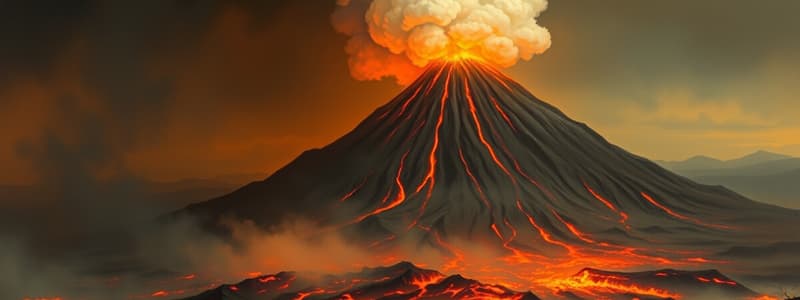Podcast
Questions and Answers
Which type of volcano is characterized by broad, gently sloping sides and eruptions of low-viscosity lava?
Which type of volcano is characterized by broad, gently sloping sides and eruptions of low-viscosity lava?
- Stratovolcanoes
- Shield Volcanoes (correct)
- Supervolcanoes
- Cinder Cone Volcanoes
What is a notable feature of stratovolcanoes?
What is a notable feature of stratovolcanoes?
- They produce large volumes of basaltic lava forming plateaus.
- They have steep, conical shapes with layers of different materials. (correct)
- They erupt along cracks in the Earth.
- They are predominantly located underwater.
What typically describes a cinder cone volcano?
What typically describes a cinder cone volcano?
- It consists predominantly of volcanic debris and has steep slopes. (correct)
- It can create extensive island chains under the sea.
- It has a broad structure formed from the overflow of lava.
- It forms large calderas from collapsed magma chambers.
What is a characteristic of lava domes?
What is a characteristic of lava domes?
What distinguishes supervolcanoes from other types of volcanoes?
What distinguishes supervolcanoes from other types of volcanoes?
Flashcards are hidden until you start studying
Study Notes
Kinds of Volcanoes
-
Shield Volcanoes
- Broad, gently sloping sides.
- Built up by the eruption of low-viscosity basalt lava that can flow over great distances.
- Example: Mauna Loa, Hawaii.
-
Stratovolcanoes (Composite Volcanoes)
- Steep, conical shape with layers of lava, ash, and volcanic rock.
- Eruptions are often explosive, with viscous lava that doesn't flow far.
- Example: Mount St. Helens, USA.
-
Cinder Cone Volcanoes
- Smallest type of volcano, steep slopes made from volcanic debris.
- Formed from the accumulation of cinders and ash around a single vent.
- Eruptions are usually short-lived and mildly explosive.
- Example: Paricutin, Mexico.
-
Lava Domes
- Formed by the slow extrusion of highly viscous lava.
- Often found within the craters of larger volcanoes.
- Can collapse or explode due to pressure buildup.
- Example: Novarupta Lava Dome, Alaska.
-
Fissure Volcanoes
- Eruptions occur along cracks in the Earth's surface rather than a single volcanic vent.
- Typically produce large volumes of basaltic lava that form extensive plateaus.
- Example: Iceland’s Laki fissure eruption.
-
Submarine Volcanoes
- Located underwater, often forming island chains as they erupt and build up.
- Can lead to the formation of new islands (e.g., Loihi, Hawaii).
- Eruptions can be explosive, producing steam and ash.
-
Supervolcanoes
- Capable of producing extremely large and explosive eruptions.
- Often characterized by calderas formed from collapsed magma chambers.
- Example: Yellowstone Caldera, USA.
Types of Volcanoes
-
Shield Volcanoes
- Characterized by broad, gently sloping sides.
- Eruptions feature low-viscosity basalt lava that flows over long distances.
- Notable example includes Mauna Loa in Hawaii.
-
Stratovolcanoes (Composite Volcanoes)
- Have a steep conical shape and are composed of alternating layers of lava, ash, and volcanic rocks.
- Eruptions tend to be explosive due to the high viscosity of the lava.
- A well-known example is Mount St. Helens in the USA.
-
Cinder Cone Volcanoes
- Represent the smallest type of volcano, with steep slopes formed from volcanic debris.
- Created by the accumulation of cinders and ash around a single vent.
- Eruptions are usually short-lived and mildly explosive, such as the eruption of Paricutin in Mexico.
-
Lava Domes
- Formed by the slow extrusion of highly viscous lava.
- Typically found within the craters of larger volcanoes.
- Can experience collapse or explosive eruptions due to pressure buildup; example: Novarupta Lava Dome in Alaska.
-
Fissure Volcanoes
- Eruptions occur along cracks in the Earth's surface rather than from a singular volcanic vent.
- These volcanoes produce large volumes of basaltic lava, resulting in extensive plateaus.
- An example is the Laki fissure eruption in Iceland.
-
Submarine Volcanoes
- Situated underwater, often contributing to the formation of island chains during eruptions.
- Can lead to the emergence of new islands, as seen with Loihi in Hawaii.
- Eruptions may be explosive, often resulting in the creation of steam and ash.
-
Supervolcanoes
- Capable of generating extremely large and explosive eruptions with far-reaching effects.
- Distinguished by the presence of calderas formed from collapsed magma chambers.
- Yellowstone Caldera in the USA is a prominent example.
Studying That Suits You
Use AI to generate personalized quizzes and flashcards to suit your learning preferences.




